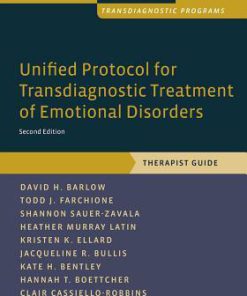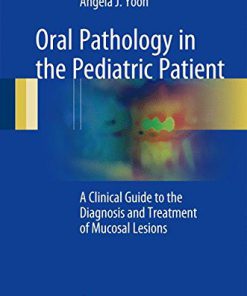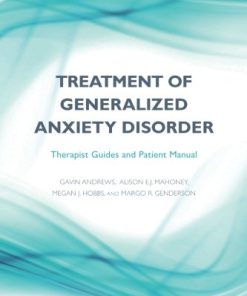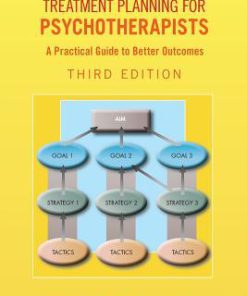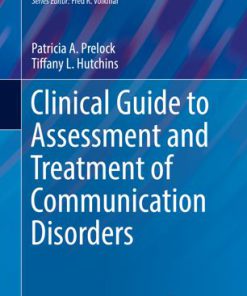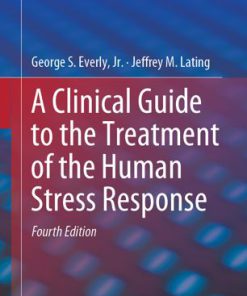Therapist’s guide to clinical intervention the 1 2 3’s of treatment planning 3rd Edition by Johnson 0128111763 9780128111765
$50.00 Original price was: $50.00.$25.00Current price is: $25.00.
Therapist’s guide to clinical intervention the 1-2-3’s of treatment planning 3rd Edition by Johnson- Ebook PDF Instant Download/Delivery:0128111763,9780128111765
Full download Therapist’s guide to clinical intervention the 1-2-3’s of treatment planning 3rd Edition after payment
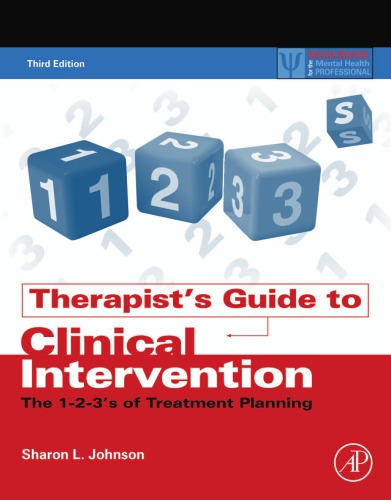
Product details:
ISBN 10:0128111763
ISBN 13:9780128111765
Author:Johnson
Therapist’s Guide to Clinical Intervention, Third Edition, is an essential reference for providing clinical services and associated case formulations requiring formalized goals and objectives. It is ideal for use in assessment, treatment, consultation, completing insurance forms, and/or participating in managed care. This practical, hand-on book, outlines treatment goals and objectives for each type of psychopathology as defined by the diagnostic and statistical manual by the American Psychiatric Association. It additionally provides skill-building resources and samples of all major professional forms likely to be used in clinical treatment.
The third edition conveniently maps individualized treatment plans utilizing evidence-based best practices and standards of care. Diagnostic information is presented by associated disorder or theme for easier access. New special assessments and skill-building entries are included. Also new are numerous website/URLs associated with research articles, and consumer resources have been provided to complement clinical information and patient education.
Therapist’s guide to clinical intervention the 1-2-3’s of treatment planning 3rd Table of contents:
Chapter 1. Treatment Planning: Goals, Objectives, and Interventions
Neurodevelopmental Disorders
Disruptive Behavior Disorders
Impulse Control Disorders
Separation Anxiety
Pediatric Generalized Anxiety Disorder
Feeding and Eating Disorders
Recommendations for Family Members of Anorexic Individuals
Neurocognitive Disorders
Dementia
Substance-Related and Addictive Disorders
List of Symptoms Leading to Relapse
Schizophrenia Spectrum and Other Psychotic Disorders
Mood Disorders
Bipolar Disorder
Bipolar Disorder Hypersexuality
Antidepressant Medication and Other Treatment for Major Depression
Anxiety Disorders
Cycle of Anxiety-Provoked Emotional Distress
Somatic Symptoms and Related Disorders
Dissociative Disorders
Sexual Dysfunctions
Gender Dysphoria
Adjustment Disorders
Personality Disorders
Obsessive–Compulsive Personality Disorder
Physical Factors Affecting Psychological Functioning
Chapter 2. Assessing Special Circumstances
Assessing Special Circumstances
The Individualized Journey of Mental Illness
Crisis Assessment
Structured Interview for Depression and Anxiety
Cycle of Depression and/or Anxiety: A Cognitive-Behavioral Therapy Assessment
Cycle of Depression and/or Anxiety: A Cognitive-Behavioral Therapy Assessment
Cognitive-Behavioral Therapy Assessment
Psychiatric Crisis Evaluation
Risk Management
Summary of Lanterman–Petris–Short Act
Suicide
Dangerousness
Gravely Disabled
Activities of Daily Living
Crisis Assessment
Crisis Assessment, Intervention, and Traumatic Exposure
Traumatic Stress and Physical Injury
Obsessional Disorders: An Overview
Assessment of Obsessional Disorders
Cycle of Phobic Anxiety
Assessment of Phobic Behavior
Postpartum Depression, Anxiety, and Psychosis
Chronic Mental Illness
Self-care Behaviors
Medical Crisis Assessment and Counseling
Dealing With the Challenges of Long-Term Illness
Working Through the Challenges and Fears Associated With Long-Term Illness
Chronic Pain: Assessment and Intervention
The Pain Scale
Pain Management Diary
Daily Pain Diary Worksheet
Somatic Problems: A Brief Review
The Patient With Psychosomatic Illness Who Has an Underlying Personality Disorder
Eating Disorder Screening and Assessment
Eating Disorders Screening Questionnaire
The SCOFF Questionnaire (Morgan, Reid, & Lacey, 2000)
The Mood Eating Scale
Eating History
Checklist of Observable Eating Disorder Behaviors
Eating Disorder Evaluation: Anorexia
Eating Disorder Evaluation: Bulimia
Attention-Deficit Disorder
Adult Attention-Deficit Disorder Screening
Attention-Deficit/Hyperactivity Disorder Behavioral Review (Child)
Substance Use Screening and Assessment
Substance Use Assessment
Substance Use Psychological Assessment
Substance use History
Substance Use Disorders Withdrawal
Withdrawal Symptoms Checklist
Domestic Violence
The Family Systems Model of Domestic Violence
The Cycle of Violence
The Domestic Violence Assessment Process
Meeting the Patient Where They Are
Counseling Victims of Domestic Violence (Lee, 2007)
Compulsory Psychological Evaluation Referral
Psychiatric Work-Related Disability Evaluation
Functional Capacity Evaluation
Consultive Examination
Child Abuse and Neglect
Child Custody Evaluation
Child Custody Evaluation Report Outline
Parental Alienation Syndrome
Criteria for Establishing Primary Custody
Basis for Family Court Child Custody Recommendations
Preparing a Parent for Child Custody Evaluation Process
Preparing Parents for the Child Custody Evaluation: A Checklist of Do’s and Don’ts
Evaluation and Disposition Considerations for Families Where Parental Alienation Occurs
Parental Alienation Syndrome Intervention
Visitation Rights Report
Dispositional Review: Foster Placement; Temporary Placement
Learning Disabilities Assessment and Evaluation
Role of Legislation
Differential Diagnosis (Learning Disabilities vs. Other Conditions)
Chapter 3. Skill Building Resources for Increasing Social Competency
What Is Stress?
Stress Management
Effective Management of Stress
Tips for Stress Management
Simplifying Life as a Means to Decrease Stress
Individualized Time Management for Decreasing Stress
Self-Care Plan
How to Get the Most Out of Your Day
Relaxation Exercises
Managing Depression and Anxiety
Using a Mood and Thought Chart as a Management Tool
Depression Symptom Checklist
Managing Depression
Challenging Depression
Surviving the Holiday Blues
What Is Mania?
Anxiety Symptom List
Decreasing or Eliminating the Intensity of Anxiety Symptoms
25 Ways to Relieve Anxiety
Managing Anxiety
Dealing With Fear Associated With Anxiety
Stopping the Anxiety Cycle
Relapse—Symptom Reoccurrence
Warning Signs of Relapse
Systematic Desensitization
What Is Panic Anxiety?
Exposure Therapy
Posttraumatic Stress Disorder
Treating Posttraumatic Stress Disorder
Defeating Posttraumatic Stress Disorder
Substance Abuse, Relapse, and Codependency
Enabling and Codependency
The Classic Situation
Some Characteristics of Codependence
The Rules of Codependency
How Does Codependency Work
The Enabler—The Companion to the Dysfunctional/Substance-Abusing Person
Characteristics of Adult Children of Alcoholics
Challenging Codependency
Guidelines for Family Members/Significant Others of Alcoholic/Chemically Dependent Individuals
Stages of Recovery
Detaching With Love Versus Controlling
Personality Disorders
The Relationship Between a Person Who Has a Personality Disorder and a Person Who Doesn’t (Nonpersonality Disorder)
Toolbox for the Nonpersonality-Disordered Individual and Coping in a Relationship With a Personality-Disordered Individual
Personality Disorder Toolbox
Dementia
Caregiver Education
Ten Warning Signs of Caregiver Stress
Mental Health Crisis Planning
Recovering From a Mental Health Crisis
Suicide
Feeling Overwhelmed and Desperate
Feeling Like Your Life Is Out of Control
Guilt
Loneliness
General Management Skills
Building a Strong Support System
How to Build and Keep a Support System
Self-Monitoring Checklist
Daily Activity Schedule
Challenging Negative and Irrational Self-talk
Rational Thinking
Thinking Distortions
Realistic Self-Talk
Practice Reframing How You Interpret Situations
Defense Mechanisms
Defense Mechanism Definitions
Defense Mechanisms
Overcoming Worry
Anger Management
How to Handle Angry People
Boundaries
Establishing Healthy Boundaries
The Consequences of Unhealthy Boundaries and Healthy Boundaries
Marital Boundaries
Death of a Marriage
Assertive Communication Defined
Personal Bill of Rights
Assertiveness Inventory
Assertiveness Checklist
Assertive Communication
Ten Ways of Responding to Aggression
Building Self-esteem
Characteristics of Self-esteem
The Self-Esteem Review
Characteristics of Low Self-esteem
Low Self-esteem
Ten Self-Esteem Boosters
Affirmations for Building Self-esteem
Self-nurturing: A Component of Self-esteem
Characteristics of High Self-Esteem
Self-Confidence
Programming Self-Confidence (Richard Bandler, Alessio Roberti, and Owen Fitzpatick)
Personal Empowerment
Resilience
Self-Determination
Building Self-advocacy Skills in Children
Goals and Motivation
Journal Writing
Self-Monitoring
Goal Development
Goal Setting
Accomplishments
Strengths
Resources
Problem Solving
Problem-Solving Process
Assignment 1
Assignment 2
Assignment 3
Risks
Decision Making
Time Management
Examples of Individualized Time Management Options
Mindfulness
How to Practice Mindfulness
Dealing With Loss and Grief
Learning History
Losses/Opportunities
Grief
Definition: The Natural Emotional Response to the Loss of a Cherished Idea, Person, or Thing
History of Loss Graph
Coping With Loss and Grief
Losing a Family Member or Friend to Suicide
Physical Health
Assuming the Patient Role: The Benefits of Being Sick
Improving Your Health
Sleep
Ten Tips for Better Sleep and Recovery
Eating and Nutrition
Stop Using Food as a Coping Mechanism
Preventing Weight and Body Image Problems in Children
Guidelines to Follow if Someone You Know Has an Eating Disorder
Relationships
Healthy Adult Relationships: Being a Couple
Improved Coping Skills for Happier Couples
Couple’s Conflict: Rules for Fighting Fair
Problem Resolution
Domestic Violence
Domestic Violence: Safety Planning
Why Victims of Domestic Violence Struggle With Leaving
Surviving Divorce
Letting Go of the Past
Parenting a Healthy Family
Guiding Your Child to Appropriately Express Anger
The Family Meeting
Family Facing a Crisis
What Happens During a Crisis
Understanding and Dealing With Life Crises of Childhood
Crisis Resolution
Your Child’s Mental Health
Warning Signs of Teen Mental Health Problems
Talking to Children
Boundaries With Children
Guidelines for Discipline That Develops Responsibility
Children Surviving Divorce
Helping Children Cope With Scheduling Changes
Is Your Behavior in the Best Interest of Your Children?
Successful Stepfamily Characteristics
Chapter 4. Professional Practice Forms Clinical Forms Business Forms
Case Formulation
Initial Patient Evaluation Consultation Note to Primary Care Physician
Brief Consultation Note to Physician
General Clinical Evaluation
Treatment Plan
Mental Status Exam
Mental Status Exam
Brief Mental Status Exam Form
Mental Status Exam
Initial Case Assessment
Initial Evaluation
Brief Mental Health Evaluation Review
Life History Questionnaire
Adult Psychosocial
Summary
Child/Adolescent Psychosocial
Parent’s Questionnaire
Self-assessment
Brief Medical History
Illnesses and Medical Problems
Medical Review Consult Request for Primary Care Physician of an Eating Disorder Patient
Substance Used and Psychosocial Questionnaire
Chemical Dependency Psychosocial Assessment
Brief Consultation Note to Physician
Outpatient Treatment Progress Report
Progress Note for Individual With Anxiety and/or Depression
Clinical Notes
Outline for Diagnostic Summary
Discharge Summary
Reports Associated With Disability or Workers′ Compensation
Disability/Worker’s Compensation
Social Security Evaluation Medical Source Statement, Psychiatric/Psychological
Worker’s Compensation Attending Therapist’s Report
Brief Psychiatric Evaluation for Industrial Injury
Brief Level of Functioning Review for Industrial Injury
Patient Registration
Contract for Services Without Using Insurance
Fee Agreement for Deposition and Court Appearance
Limits on Patient Confidentiality
Treatment Contract
Contract for Group Therapy
Authorization for the Release or Exchange of Information
Pediatric Patient Registration
Release for the Evaluation and Treatment of a Minor
Client Messages
Affidavit of the Custodian of Mental Health Records to Accompany Copy of Records
Referral for Psychological
Release to Return to Work or School
Notice of Discharge for Noncompliance of Treatment
Duty to Warn
Missed Appointment
Receipt
Receipt
Balance Statement
Client Satisfaction Survey
Form for Checking Out Audio CDS, DVDS, and Books
Mental Health Record Review
Chart Content Review
People also search for Therapist’s guide to clinical intervention the 1-2-3’s of treatment planning 3rd :
therapist’s guide to clinical intervention 3rd edition
therapist’s guide to clinical intervention
what are some counseling interventions
what are some therapeutic interventions
a therapist’s guide to child development
Tags:
Johnson,clinical,intervention,Therapist’s
You may also like…
Medicine - Dentistry
Surgery First Orthodontic Management A Clinical Guide to a New Treatment Approach Chai Kiat Chng
Politics & Philosophy - Social Sciences
Psychology - Psychological Disorders
Medicine
Treatment Planning for Psychotherapists A Practical Guide to Better Outcomes Richard B Makover
Psychology - Psychotherapy
A Guide to Crisis Intervention 6th Edition by Kristi Kanel 8214344850 9798214344850
Relationships & Lifestyle - Health - Diseases & Disorders
Religion & Spirituality





